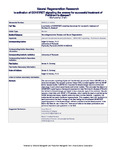Is activation of GDNF/RET signaling the answer for successful treatment of Parkinson’s disease? A discussion of data from the culture dish to the clinic
| dc.contributor.author | Conway, James | |
| dc.contributor.author | Kramer, Edgar | |
| dc.date.accessioned | 2021-08-16T10:32:49Z | |
| dc.date.issued | 2021-12-10 | |
| dc.identifier.issn | 1876-7958 | |
| dc.identifier.issn | 1876-7958 | |
| dc.identifier.uri | http://hdl.handle.net/10026.1/17596 | |
| dc.description.abstract |
The neurotrophic signaling of glial cell line-derived neurotrophic factor (GDNF) with its canonical receptor, the receptor tyrosine kinase RET, coupled together with the GDNF family receptor alpha 1 is important for dopaminergic neuron survival and physiology in cell culture experiments and animal models. This prompted the idea to try GDNF/RET signaling as a therapeutic approach to treat Parkinson's disease with the hallmark of dopaminergic cell death in the substantia nigra of the midbrain. Despite several clinical trials with GDNF in Parkinson's disease patients, which mainly focused on optimizing the GDNF delivery technique, benefits were only seen in a few patients. In general, the endpoints did not show significant improvements. This suggests that it will be helpful to learn more about the basic biology of this fascinating but complicated GDNF/RET signaling system in the dopaminergic midbrain and about recent developments in the field to facilitate its use in the clinic. Here we will refer to the latest publications and point out important open questions in the field. | |
| dc.format.extent | 1462-1467 | |
| dc.format.medium | ||
| dc.language | en | |
| dc.language.iso | en | |
| dc.publisher | Medknow Publications | |
| dc.subject | alpha-synuclein | |
| dc.subject | clinical trials | |
| dc.subject | dopaminergic neurons | |
| dc.subject | glial cell line-derived neurotrophic factor | |
| dc.subject | GFR alpha 1 | |
| dc.subject | gut-brain axis | |
| dc.subject | Nedd4 | |
| dc.subject | Parkin | |
| dc.subject | Parkinson's disease | |
| dc.subject | RET | |
| dc.title | Is activation of GDNF/RET signaling the answer for successful treatment of Parkinson’s disease? A discussion of data from the culture dish to the clinic | |
| dc.type | journal-article | |
| dc.type | Journal Article | |
| dc.type | Review | |
| plymouth.author-url | https://www.webofscience.com/api/gateway?GWVersion=2&SrcApp=PARTNER_APP&SrcAuth=LinksAMR&KeyUT=WOS:000766430900011&DestLinkType=FullRecord&DestApp=ALL_WOS&UsrCustomerID=11bb513d99f797142bcfeffcc58ea008 | |
| plymouth.issue | 7 | |
| plymouth.volume | 17 | |
| plymouth.publication-status | Published | |
| plymouth.journal | Neural Regeneration Research | |
| dc.identifier.doi | 10.4103/1673-5374.327330 | |
| plymouth.organisational-group | /Plymouth | |
| plymouth.organisational-group | /Plymouth/Faculty of Health | |
| plymouth.organisational-group | /Plymouth/Faculty of Health/Peninsula Medical School | |
| plymouth.organisational-group | /Plymouth/Faculty of Science and Engineering | |
| plymouth.organisational-group | /Plymouth/REF 2021 Researchers by UoA | |
| plymouth.organisational-group | /Plymouth/REF 2021 Researchers by UoA/UoA01 Clinical Medicine | |
| plymouth.organisational-group | /Plymouth/Users by role | |
| plymouth.organisational-group | /Plymouth/Users by role/Academics | |
| dc.publisher.place | India | |
| dcterms.dateAccepted | 2021-07-12 | |
| dc.rights.embargodate | 2021-12-14 | |
| dc.identifier.eissn | 1876-7958 | |
| dc.rights.embargoperiod | Not known | |
| rioxxterms.versionofrecord | 10.4103/1673-5374.327330 | |
| rioxxterms.licenseref.uri | http://www.rioxx.net/licenses/all-rights-reserved | |
| rioxxterms.licenseref.startdate | 2021-12-10 | |
| rioxxterms.type | Journal Article/Review |


